Most innovative companies for 07/09/2024 (new inventions)
Exciting new inventions from Samsung Electronics Co., Ltd., Apple Inc., Qualcomm Incorporated And Huawei Technologies Co., Ltd.
This is a weekly article summarizing a handful of inventions from the most innovative companies in the world. The summaries are created by an A. I. and proof-read by a human before publication. Attempts are made to ensure accuracy of the descriptions, but it is very much a work in progress. Each invention description is preceeded by a poem about the invention that is written by the A. I. I have found the limerick is actually quite good at explaining the invention in simple terms. Enjoy!
Samsung Electronics Co., Ltd.
"Samsung's New Clothes Treatment Apparatus Revolutionizes Laundry Time Management"
What is this invention?
Clothes treatment apparatus and method for controlling the same
Innovative tech for clothes treatment shown,
A processor detects weight when program's thrown,
Drum for clothes, with programs to choose,
Displaying time left, no time to lose,
Efficiently washing, in tables all known.

Samsung Electronics Co., Ltd. recently unveiled a patented clothes treatment apparatus that aims to revolutionize the way we do laundry. This innovative device boasts a sleek design and a range of cutting-edge features, including a drum for clothes, an intuitive inputter for selecting programs, and a storage system to store information on settings and operation times. Competitors in the market, such as LG and Whirlpool, offer similar products, but Samsung's clothes treatment apparatus sets itself apart with its advanced technology. The processor in this apparatus is capable of detecting the weight of clothes to optimize the treatment process, ensuring efficient and effective cleaning every time. Imagine a future where doing laundry is no longer a chore but a seamless, automated experience thanks to Samsung's invention. With its user-friendly interface and customizable programs, this clothes treatment apparatus could save us time and energy, allowing us to focus on more important tasks. But will this patent translate into a tangible product that consumers can purchase? Will Samsung be able to overcome any potential design or production challenges to bring this innovation to market successfully? Share your thoughts in the comments below.
Abstract
Disclosed herein is a clothes treatment apparatus. The clothes treatment apparatus includes a drum configured to accommodate clothes, an inputter configured to receive one of a plurality of programs and configured to receive a start command, a storage configured to store information on a setting time corresponding to a weight of clothes for each program and configured to store information on a default time for each program previously executed, in the form of tables, a processor configured to detect a weight of clothes when any one program is received and a start command is received, configured to identify a setting time corresponding to the detected weight of clothes and the received program, configured to control the execution of the received program based on the identified setting time, and configured to store an operation time, which is taken until the completion of the received program, as a default time, and a display configured to display a remaining time during the execution of the received program. Disclosed herein is a clothes treatment apparatus. The clothes treatment apparatus includes a drum configured to accommodate clothes, an inputter configured to receive one of a plurality of programs and configured to receive a start command, a storage configured to store information on a setting time corresponding to a weight of clothes for each program and configured to store information on a default time for each program previously executed, in the form of tables, a processor configured to detect a weight of clothes when any one program is received and a start command is received, configured to identify a setting time corresponding to the detected weight of clothes and the received program, configured to control the execution of the received program based on the identified setting time, and configured to store an operation time, which is taken until the completion of the received program, as a default time, and a display configured to display a remaining time during the execution of the received program.
US Patent 12031257
Samsung Electronics Co., Ltd.
"Samsung Patents Innovative Clock Conversion Device for Enhanced Test Systems"
What is this invention?
Clock conversion device, test system having the same, and method of operating test system
There once was a clock conversion device,
For test systems it came to be nice,
First clock signal is spruced,
Frequency multiplied, phase locked, induced,
Outputting signals precise as ice.
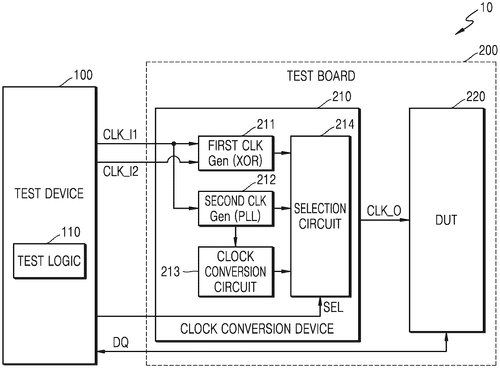
The latest patent from Samsung Electronics Co., Ltd. introduces a clock conversion device designed for use in test systems. This device includes innovative features such as a first clock generator, a clock conversion circuit, and an output selector to provide an output clock signal to a device under test (DUT). Competitors in the market, such as Intel and Qualcomm, offer similar products that aim to enhance testing processes in electronic devices. With Samsung's new clock conversion device, potential uses could range from improving the efficiency of testing procedures in manufacturing plants to optimizing the performance of electronic devices during development stages. It remains to be seen whether this patent will translate into a tangible product available to consumers. How do you think this technology could impact the future of electronic device testing? Share your thoughts in the comments below.
Abstract
Provided are a clock conversion device, a test system including the same, and a method of operating the test system. The clock conversion device includes a first clock generator configured to receive a first input clock signal from test logic and generate a first clock signal of which a frequency is multiplied and a phase is locked; a clock conversion circuit configured to receive the first clock signal and generate one or more second clock signals by converting at least one clock characteristic of the first clock signal; and an output selector configured to output any one of the first clock signal and the one or more second clock signals as an output clock signal, wherein the clock conversion device is configured to provide the output clock signal to a device under test (DUT). Provided are a clock conversion device, a test system including the same, and a method of operating the test system. The clock conversion device includes a first clock generator configured to receive a first input clock signal from test logic and generate a first clock signal of which a frequency is multiplied and a phase is locked; a clock conversion circuit configured to receive the first clock signal and generate one or more second clock signals by converting at least one clock characteristic of the first clock signal; and an output selector configured to output any one of the first clock signal and the one or more second clock signals as an output clock signal, wherein the clock conversion device is configured to provide the output clock signal to a device under test (DUT).
US Patent 12032019
Samsung Electronics Co., Ltd.
"Samsung's Innovative Depth Detection System Incorporates Histogram Binning Technology"
What is this invention?
System and method for histogram binning for depth detection
In the depths of tech innovation's domain,
A system for depth detection to gain.
With histograms binned,
And light pulses pinned,
Time of flight measured, a technological chain.
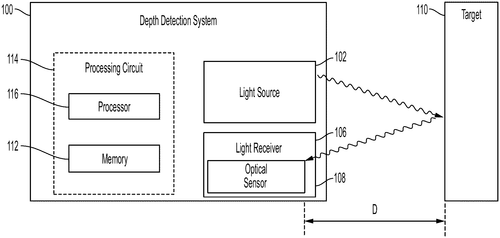
Samsung Electronics Co., Ltd. has recently unveiled a new depth detection system and method utilizing histogram binning for enhanced precision. This innovative technology incorporates a light source that emits a pulse towards an object, an optical sensor to capture the reflected light, and a processing circuit to analyze the data and determine the distance of the object based on the time it takes for the light to return. While this system boasts advanced capabilities in depth detection, it enters a competitive market with similar technologies being utilized in products like Apple's Face ID and Microsoft's Kinect. The use cases for this technology could range from improved facial recognition in smartphones to enhanced virtual reality experiences. With Samsung's depth detection system on the horizon, one can't help but wonder: Will this technology revolutionize how we interact with our devices, or will it remain a niche feature for specific applications? Share your thoughts in the comments below.
Abstract
Provided is a depth detection system and method of histogram binning for depth detection. The depth detection system includes a light source configured to emit a light pulse toward an object, an optical sensor configured to detect the light pulse reflecting off the object, the optical sensor including a first sensing pixel configured to detect the light pulse for a first event count according to the light pulse reflecting off the object, and a second sensing pixel configured to detect the light pulse for a second event count according to the light pulse reflecting off the object, and a processing circuit configured to determine a first aggregated histogram corresponding to the first sensing pixel based on the first event count and the second event count and determine a first peak of the first aggregated histogram to determine a first time of flight associated with the first sensing pixel. Provided is a depth detection system and method of histogram binning for depth detection. The depth detection system includes a light source configured to emit a light pulse toward an object, an optical sensor configured to detect the light pulse reflecting off the object, the optical sensor including a first sensing pixel configured to detect the light pulse for a first event count according to the light pulse reflecting off the object, and a second sensing pixel configured to detect the light pulse for a second event count according to the light pulse reflecting off the object, and a processing circuit configured to determine a first aggregated histogram corresponding to the first sensing pixel based on the first event count and the second event count and determine a first peak of the first aggregated histogram to determine a first time of flight associated with the first sensing pixel.
US Patent 12032065
Samsung Electronics Co., Ltd.
"Innovative Pellicle Cleaning Apparatus by Samsung Electronics Co., Ltd. Sets New Standards in Surface Particle Remover Technology"
What is this invention?
Pellicle cleaning apparatus and pellicle cleaning method using the same
In a lab of technology arrayed,
A pellicle cleaning apparatus displayed,
With a remover so fine,
To rid particles, a design,
Pressure controlled, innovation conveyed.
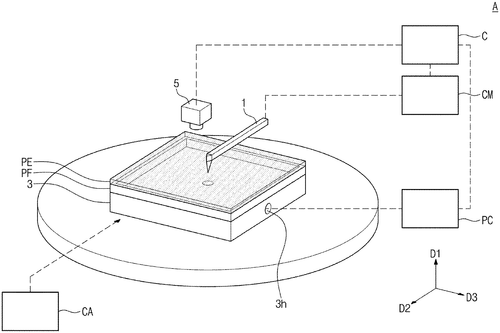
Samsung Electronics has recently unveiled a new patent for a pellicle cleaning apparatus, designed to remove particles from the surface of delicate pellicles used in various industries. This innovative device features a particle remover with a cantilever and adhesive material, supported by a stage and a pressure controller to manage fluid pressure on the pellicle's surface. While this technology shows promise in enhancing the maintenance of pellicles, it faces competition from existing cleaning solutions in the market. However, Samsung's design offers a unique approach that could potentially revolutionize the cleaning process for pellicles used in fields such as semiconductor manufacturing and advanced optics. Imagine the possibilities of this pellicle cleaning apparatus in streamlining production processes and ensuring optimal performance of precision equipment. Could this invention become a game-changer in the industry, or will it face challenges in practical implementation? Share your thoughts in the comments below.
Abstract
A pellicle cleaning apparatus includes a stage to support a pellicle, a particle remover above the stage, the particle remover being configured to remove a particle from a first surface of a pellicle, and the particle remover including a cantilever, and an adhesive material on a bottom surface of the cantilever, and a pressure controller adjacent to the stage, the pressure controller being configured to control a pressure of a fluid on a second surface of the pellicle. A pellicle cleaning apparatus includes a stage to support a pellicle, a particle remover above the stage, the particle remover being configured to remove a particle from a first surface of a pellicle, and the particle remover including a cantilever, and an adhesive material on a bottom surface of the cantilever, and a pressure controller adjacent to the stage, the pressure controller being configured to control a pressure of a fluid on a second surface of the pellicle.
US Patent 12032281
Samsung Electronics Co., Ltd.
"Samsung's Innovative Integrated Circuit Revolutionizes Power Efficiency in Electronics"
What is this invention?
Integrated circuit and electronic device including the same
In a circuit of power so fine,
LDO regulators align,
First source voltage they take,
For load current to make,
Efficient, this design does shine.
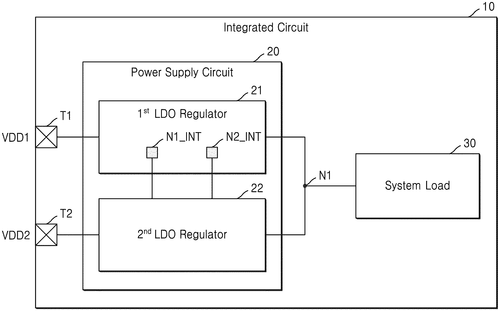
Samsung Electronics Co., Ltd. has recently filed a patent for an innovative integrated circuit that features a power supply circuit capable of generating a supply voltage from multiple power source voltages. The system load is designed to operate by receiving the supply voltage through an output node of the power supply circuit. This new technology includes a first low drop-output (LDO) regulator that generates a load current from the first power source voltage, along with a second LDO regulator that selectively generates a load current from the second power source voltage based on voltage differentials within the system. Competitors like Intel and Qualcomm have also been exploring similar power supply solutions for their integrated circuits. If brought to market, this invention could have a wide range of potential uses, from enhancing the energy efficiency of smartphones and laptops to improving the performance of IoT devices and wearables. The question that arises is, how will this advanced power supply technology impact the future development of electronics? Will it lead to more energy-efficient devices or pave the way for new applications in the realm of smart technology? Share your thoughts in the comments below.
Abstract
An integrated circuit includes: a power supply circuit configured to generate a supply voltage from at least one of first and second power source voltages; and a system load configured to operate by receiving the supply voltage through an output node of the power supply circuit, wherein the power supply circuit includes: a first low drop-output (LDO) regulator configured to generate, from the first power source voltage, a first load current flowing to the system load through the output node; and a second LDO regulator configured to selectively generate a second load current flowing to the system load through the output node, from the second power source voltage based on a difference between voltages of internal nodes of the first LDO regulator. An integrated circuit includes: a power supply circuit configured to generate a supply voltage from at least one of first and second power source voltages; and a system load configured to operate by receiving the supply voltage through an output node of the power supply circuit, wherein the power supply circuit includes: a first low drop-output (LDO) regulator configured to generate, from the first power source voltage, a first load current flowing to the system load through the output node; and a second LDO regulator configured to selectively generate a second load current flowing to the system load through the output node, from the second power source voltage based on a difference between voltages of internal nodes of the first LDO regulator.
US Patent 12032399
SAMSUNG ELECTRONICS CO., LTD.
"Samsung Patents Groundbreaking Blood Pressure Estimating Apparatus with Independent Cardiovascular Features"
What is this invention?
Blood pressure estimating apparatus and blood pressure estimating method
In the realm of tech innovation, there lies
An apparatus that's truly wise
Estimating blood pressure so fine
With features that intertwine
Changing tendencies to analyze.
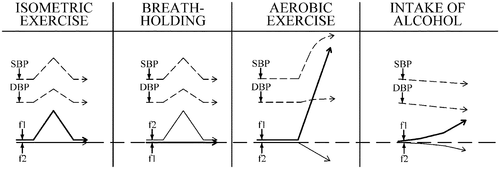
Samsung Electronics Co., Ltd. has recently been granted a patent for a blood pressure estimating apparatus that has the potential to revolutionize the way we monitor our cardiovascular health. This innovative device includes a sensor to capture a bio-signal and a processor to analyze key cardiovascular features to estimate blood pressure accurately. This new invention could potentially rival existing blood pressure monitors on the market by offering a more seamless and efficient method of tracking one's cardiovascular health. Imagine having a compact device that can provide accurate blood pressure readings with just a simple bio-signal input. With the increasing focus on personal health monitoring devices, this patent from Samsung has the potential to be a game-changer in the healthcare industry. But the big question remains: Will this innovative blood pressure estimating apparatus make its way to the market and become a household necessity for health-conscious individuals? Share your thoughts in the comments below.
Abstract
A blood pressure estimating apparatus includes a sensor configured to obtain a bio-signal of an object; and a processor configured to extract a first cardiovascular feature and a second cardiovascular feature based on the bio-signal, and estimate blood pressure based on a first changing tendency of the first cardiovascular feature from a first reference level and a second changing tendency of the second cardiovascular feature from a second reference level, the first changing tendency and the second changing tendency being independent from each other. A blood pressure estimating apparatus includes a sensor configured to obtain a bio-signal of an object; and a processor configured to extract a first cardiovascular feature and a second cardiovascular feature based on the bio-signal, and estimate blood pressure based on a first changing tendency of the first cardiovascular feature from a first reference level and a second changing tendency of the second cardiovascular feature from a second reference level, the first changing tendency and the second changing tendency being independent from each other.
US Patent 12029592
SAMSUNG ELECTRONICS CO., LTD.
"Innovative Medical Image Transmission Method Patent by Samsung Electronics Co., Ltd. Reduces Data Processing and Transmission"
What is this invention?
Medical imaging apparatus to automatically determine presence of an abnormality including a determination to transmit an assistance image and a classified abnormality stage
In the world of medical images we see,
A method to transmit them with glee,
First determination in play,
Abnormality they say,
Minimizing data, a tech symphony!
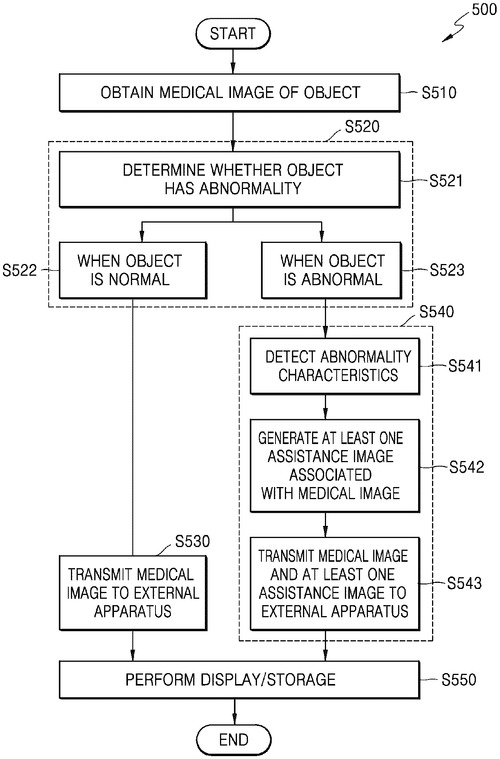
Samsung Electronics Co. has patented a new medical image transmitting method that aims to streamline the process of transmitting medical images while minimizing data processing and transmission. In this method, the system determines if an object has abnormalities and decides whether to transmit additional images accordingly. If no abnormalities are found, only the necessary medical image is sent to an external device, reducing unnecessary data transfer. This innovation could potentially revolutionize the way medical images are shared and accessed, simplifying the process for healthcare professionals and improving efficiency. Competitors in the medical imaging industry, such as GE Healthcare and Siemens Healthineers, may need to take note of this patent and consider how it could impact their own products and services. Imagine a scenario where doctors can quickly and easily transmit essential medical images to specialists for consultation without overwhelming them with unnecessary data. This could lead to faster diagnoses and more streamlined healthcare delivery. The question remains: Will this patented method be implemented into a practical product that can truly make a difference in the medical field? Share your thoughts in the comments below.
Abstract
A medical image transmitting method includes obtaining a medical image generated by imaging an object; performing a first determination to determine whether the object has an abnormality, based on the medical image; performing a second determination to determine, based on the first determination, whether to transmit at least one assistance image associated with the medical image; and when the object has no abnormalities, transmitting, to an external apparatus, the medical image, thereby minimizing a data processing amount and a data transmission amount. A medical image transmitting method includes obtaining a medical image generated by imaging an object; performing a first determination to determine whether the object has an abnormality, based on the medical image; performing a second determination to determine, based on the first determination, whether to transmit at least one assistance image associated with the medical image; and when the object has no abnormalities, transmitting, to an external apparatus, the medical image, thereby minimizing a data processing amount and a data transmission amount.
US Patent 12029614
SAMSUNG ELECTRONICS CO., LTD.
"Samsung Patents Advanced Gas Supply Apparatus with Hydrogen Generator"
What is this invention?
Apparatus for supplying gas including an ion chamber and a gas supply unit connected to the ion chamber
In a chamber of ions, oh so fine,
An apparatus for gas, a design divine,
With hydrogen generator scheme,
Removing moisture, impurity in gleam,
A marvel of tech, this creation, a sign.

Samsung Electronics Co., Ltd. has filed a patent for an apparatus that could revolutionize gas supply methods. This innovative device includes an ion chamber and a gas supply unit with unique features. The hydrogen gas supply unit, which is a key component, incorporates advanced technologies such as a hydrogen gas generator, a controller, a dehumidifying filter, and a purifying filter. While this patent showcases Samsung's commitment to developing cutting-edge technology, it also raises questions about the practicality and feasibility of such a complex apparatus. Competitors in the gas supply industry, such as Air Products and Linde, may already have established solutions that could potentially outperform Samsung's invention. Despite the potential challenges, this apparatus could find applications in various industries requiring precise gas supply systems, such as semiconductor manufacturing or medical research. The ability to generate hydrogen gas on-demand through chemical reactions sets this invention apart from conventional gas supply methods. As we delve deeper into the realm of advanced gas supply technologies, it begs the question: Will Samsung be able to bring this innovative apparatus to market successfully, or will it remain a concept confined to the patent files? Share your thoughts in the comments below.
Abstract
An apparatus for supplying gas includes: an ion chamber; and a gas supply unit connected to the ion chamber, wherein the gas supply unit includes: a case having an internal space; an inactive gas supply unit connected to the ion chamber; and a hydrogen gas supply unit installed inside or outside of the case, wherein the hydrogen gas supply unit includes: a hydrogen gas generator generating hydrogen gas; a controller connected to the hydrogen gas generator; a dehumidifying filter connected to the controller and removing moisture from the hydrogen gas; and a purifying filter connected to the dehumidifying filter and removing an impurity from the hydrogen gas, wherein the hydrogen gas generator is configured to generate the hydrogen gas through a chemical reaction between a reactant and a hydrogen-containing solid raw material. An apparatus for supplying gas includes: an ion chamber; and a gas supply unit connected to the ion chamber, wherein the gas supply unit includes: a case having an internal space; an inactive gas supply unit connected to the ion chamber; and a hydrogen gas supply unit installed inside or outside of the case, wherein the hydrogen gas supply unit includes: a hydrogen gas generator generating hydrogen gas; a controller connected to the hydrogen gas generator; a dehumidifying filter connected to the controller and removing moisture from the hydrogen gas; and a purifying filter connected to the dehumidifying filter and removing an impurity from the hydrogen gas, wherein the hydrogen gas generator is configured to generate the hydrogen gas through a chemical reaction between a reactant and a hydrogen-containing solid raw material.
US Patent 12030775
SAMSUNG ELECTRONICS CO., LTD.
"Samsung's Time-Resolving Sensor Revolutionizes Photon Detection Technology"
What is this invention?
Time-resolving sensor using SPAD + PPD or capacitors in pixel for range measurement
In a sensor of time-resolving fame,
SPAD and DTCC play the game.
With logic and charge in hand,
Output signals grand,
Capture photons without any shame.
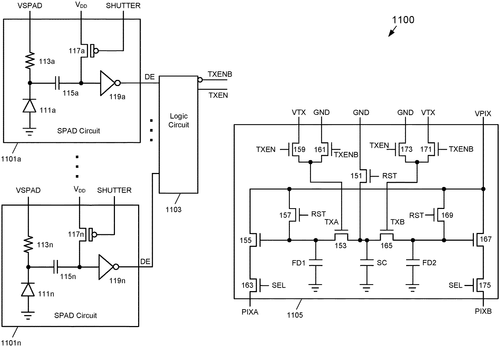
Samsung Electronics Co., Ltd. has recently patented a time-resolving sensor that incorporates advanced technology to detect incident photons with precision. The sensor features a unique combination of a single-photon avalanche diode (SPAD), logic circuit, and a differential time-to-charge converter (DTCC) circuit. This innovative design allows for the generation of output signals based on the detection of photons, enabling accurate measurement of time intervals. With competitors like Sony and Canon constantly pushing the boundaries of sensor technology in their cameras and imaging devices, Samsung's patented sensor could potentially revolutionize the way we capture images and videos. Imagine a camera that can accurately capture fast-moving objects or events with unparalleled clarity and detail, thanks to the enhanced time-resolving capabilities of this sensor. However, as with many patents in the tech industry, the question remains: Will Samsung be able to bring this groundbreaking sensor to market in a practical and cost-effective way? How would you envision incorporating this advanced time-resolving technology into your daily life or work? Share your thoughts in the comments below.
Abstract
A time-resolving sensor includes a single-photon avalanche diode (SPAD), a logic circuit and differential time-to-charge converter (DTCC) circuit. The SPAD is responsive to a shutter signal to generate an output signal based on detecting an incident photon. The logic circuit generates first and second enable signals. The DTCC includes a capacitor device, first and second switching devices, and an output circuit. The first switching device is responsive to the first enable signal to transfer a charge on the capacitor device to the first floating diffusion. The second switching device is responsive to the second enable signal to transfer a remaining charge on the capacitor device to the second floating diffusion. The output circuit outputs a first voltage that is based on the first charge on the first floating diffusion and a second voltage that is based on the second charge on the second floating diffusion. A time-resolving sensor includes a single-photon avalanche diode (SPAD), a logic circuit and differential time-to-charge converter (DTCC) circuit. The SPAD is responsive to a shutter signal to generate an output signal based on detecting an incident photon. The logic circuit generates first and second enable signals. The DTCC includes a capacitor device, first and second switching devices, and an output circuit. The first switching device is responsive to the first enable signal to transfer a charge on the capacitor device to the first floating diffusion. The second switching device is responsive to the second enable signal to transfer a remaining charge on the capacitor device to the second floating diffusion. The output circuit outputs a first voltage that is based on the first charge on the first floating diffusion and a second voltage that is based on the second charge on the second floating diffusion.
US Patent 12032064
SAMSUNG ELECTRONICS CO., LTD.
"Samsung Patents Groundbreaking Display Apparatus with Vision Correction Lens and Virtual Image Positioner"
What is this invention?
Display apparatus including vision correction lens
In a display so advanced, no less,
Comes a lens to correct eyesight stress,
The image and landscape blend,
For a view that wows without end,
Technology at its finest, no guess.
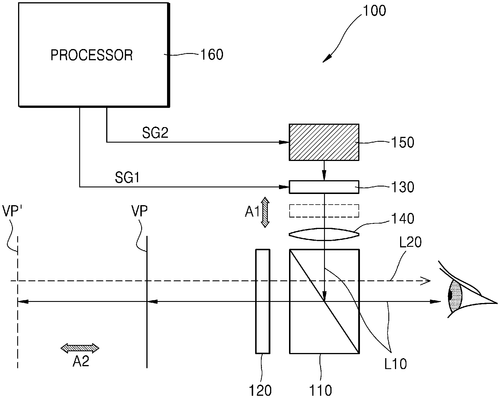
In a world where virtual reality is becoming increasingly prevalent, Samsung Electronics Co., Ltd. has patented a display apparatus that could revolutionize the way we experience the virtual world. The device includes a vision correction lens, allowing users with varying eyesight to enjoy a clear and immersive virtual image. Competing with products like Oculus Rift and HTC Vive, this display apparatus not only provides a virtual image but also integrates the outside landscape, creating a unique mixed reality experience. The virtual image positioner adjusts the depth of the virtual image plane based on the viewer's eye state, ensuring a customized and comfortable viewing experience. Imagine the potential uses of such a device - from enhancing virtual reality gaming experiences to revolutionizing virtual meetings and trainings. With Samsung at the helm of this innovation, the possibilities are endless. But the question remains - will this groundbreaking display apparatus ever make its way into the hands of consumers? Would you invest in a device that combines virtual reality with the outside world? Share your thoughts below.
Abstract
Provided is a display apparatus including a vision correction lens. The display apparatus may include: an image forming device configured to form a virtual image; a vision correction lens configured to correct eyesight of a viewer; a combiner configured to mix the virtual image with light containing an outside landscape and having passed through the vision correction lens and provide the viewer with the virtual image and the light that are mixed with each other; and a virtual image positioner configured to adjust, according to a state of eyes of the viewer, a depth of a virtual image plane at which the virtual image is viewed, wherein the combiner may be arranged between the vision correction lens and the eyes of the viewer. Provided is a display apparatus including a vision correction lens. The display apparatus may include: an image forming device configured to form a virtual image; a vision correction lens configured to correct eyesight of a viewer; a combiner configured to mix the virtual image with light containing an outside landscape and having passed through the vision correction lens and provide the viewer with the virtual image and the light that are mixed with each other; and a virtual image positioner configured to adjust, according to a state of eyes of the viewer, a depth of a virtual image plane at which the virtual image is viewed, wherein the combiner may be arranged between the vision correction lens and the eyes of the viewer.
US Patent 12032154
Apple Inc.
"Apple's Patent Reveals Innovative Round Electronic Device Case with Versatile Attachment Options"
What is this invention?
Cases for electronic devices
There once was a case so divine,
For a round tech device to shine,
With pockets and snaps,
And reinforcement wraps,
Attach it to your key chain, it's fine!

Apple Inc. has filed a patent for a round electronic device case that promises to revolutionize the way we carry and protect our gadgets. The case features a device holding portion and an attachment portion, making it versatile for use with items such as suitcases or key chains. Crafted from materials like leather, polymer, and fabric, the case boasts durability and style. Competing with other electronic device cases on the market, Apple's innovative design includes upper and lower case portions that form a pocket, providing easy access to the device. The snaps on the case are flush with the surrounding material, adding a sleek and seamless look to the overall design. Potential uses for this round electronic device case are vast, from protecting your device during travel by attaching it to your suitcase, to keeping it easily accessible by connecting it to your key chain. The reinforcement material around the openings ensures long-lasting durability, making this case a practical and stylish option for tech-savvy consumers. As we eagerly anticipate Apple's decision on whether to bring this patent to life as a product, one can't help but wonder: How would this round electronic device case enhance your daily tech experience? Share your thoughts in the comments below.
Abstract
A case for a round electronic device may have a device holding portion and an attachment portion for attaching the case to an item such as a suitcase or a key chain. The case may include upper and lower case portions that form a pocket. On a first side of the pocket, the upper and lower case portions may be stitched together or may be integrally formed. On a second side of the pocket, a snap may attach the upper case portion to the lower case portion and may be opened to provide access to the pocket. The attachment portion may have an opening for attaching the case to a key ring, suitcase, or other item. The case may include leather, polymer, and/or fabric. Openings may be surrounded by reinforcement material such as strands of non-elastic material. Snaps may be flush with surrounding portions of the case. A case for a round electronic device may have a device holding portion and an attachment portion for attaching the case to an item such as a suitcase or a key chain. The case may include upper and lower case portions that form a pocket. On a first side of the pocket, the upper and lower case portions may be stitched together or may be integrally formed. On a second side of the pocket, a snap may attach the upper case portion to the lower case portion and may be opened to provide access to the pocket. The attachment portion may have an opening for attaching the case to a key ring, suitcase, or other item. The case may include leather, polymer, and/or fabric. Openings may be surrounded by reinforcement material such as strands of non-elastic material. Snaps may be flush with surrounding portions of the case.
US Patent 12029292
Apple Inc.
"Apple Patents System for Secure Credential Enrollment and User Account Invitations"
What is this invention?
Mobile key enrollment and use
In the realm of tech so grand,
A computer system takes a stand,
Enrolling credentials secure,
With interfaces so pure,
Inviting users with a helping hand.
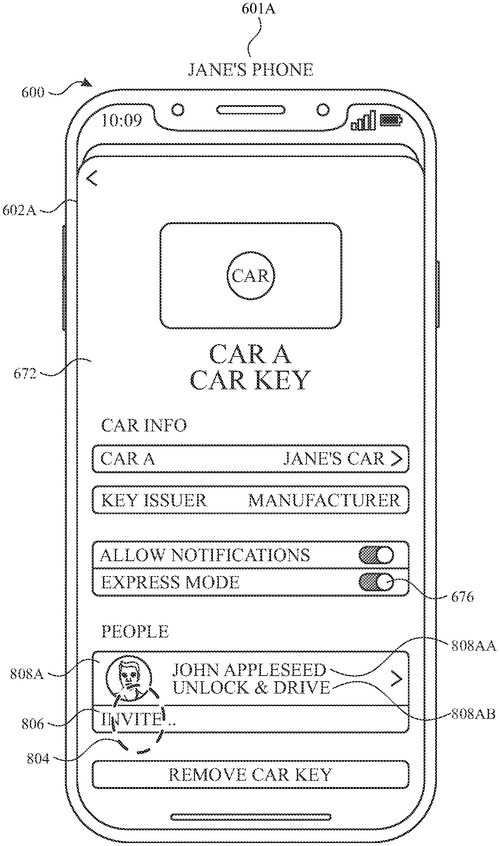
Apple Inc. has recently patented a computer system that aims to simplify the process of enrolling and using secure credentials. The system includes user-friendly interfaces for both enrolling a secure credential and inviting a user account to utilize this credential. This innovation could potentially streamline and enhance the security of online transactions and data sharing. It is worth noting that competitors in the tech industry, such as Google and Microsoft, also offer similar services, albeit with varying levels of user-friendliness and security measures. Imagine a future where managing secure credentials becomes as straightforward as using a fingerprint scanner on your smartphone. With this technology, users could securely access their accounts and make online transactions with ease and peace of mind. However, the practicality and implementation of this patent into a consumer product remain uncertain. Will Apple be able to overcome any potential obstacles and deliver this technology to the masses seamlessly? Share your thoughts in the comments below.
Abstract
A computer system performs techniques related to enrolling and using a secure credential. In some embodiments, a computer system provides user interfaces for enrolling a secure credential on the computer system. In some embodiments, a computer system provides user interfaces for inviting a user account to use a secure credential. A computer system performs techniques related to enrolling and using a secure credential. In some embodiments, a computer system provides user interfaces for enrolling a secure credential on the computer system. In some embodiments, a computer system provides user interfaces for inviting a user account to use a secure credential.
US Patent 12030458
Apple Inc.
"Apple Inc. Patent Revolutionizes Data Analysis with Anomaly Identification Techniques"
What is this invention?
Map data adjustments for anomaly correction
In datasets anomalies are found,
Computer techniques are renowned,
Elevation points askew,
Buffer points come into view,
Reducing data points, perfection is bound.
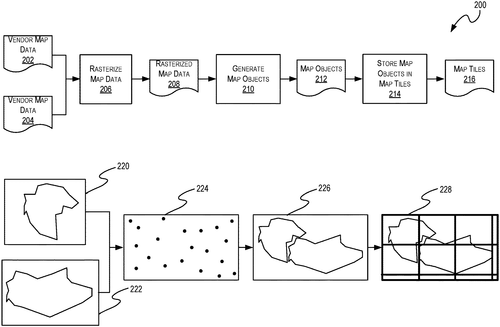
Apple Inc. has filed a patent for techniques that can identify anomalies in datasets, specifically focusing on elevation data points. This innovative technology could potentially revolutionize data analysis and mapping processes. While competitors such as Google Maps and Garmin currently lead the market in mapping technology, Apple's new approach to anomaly detection could give them a competitive edge in the field. Imagine the possibilities of using this technology in disaster response efforts, where quickly pinpointing areas with abnormal elevation changes could help prioritize rescue operations. Additionally, urban planners could benefit from identifying elevation anomalies to ensure safer construction projects. As with any new patent, the question remains: Will Apple be able to successfully implement and commercialize this technology, or will it remain a concept confined to the pages of a patent filing? Let us know in the comments below: How do you envision this anomaly detection technology being utilized in real-world applications?
Abstract
Techniques described herein may be used to identify anomalies in a joined region of two datasets. For example, a computer system may determine an elevation anomaly data point in based on an elevation criterion. The computer system may determine a set of buffer points surrounding the elevation anomaly data points. The computer system may user the set of buffer points to reduce the number of data points for adjusting. The computer system may determine a reduction factor based on the buffer points. The computer system may then apply the reduction factor to points in the buffer points and other points. Techniques described herein may be used to identify anomalies in a joined region of two datasets. For example, a computer system may determine an elevation anomaly data point in based on an elevation criterion. The computer system may determine a set of buffer points surrounding the elevation anomaly data points. The computer system may user the set of buffer points to reduce the number of data points for adjusting. The computer system may determine a reduction factor based on the buffer points. The computer system may then apply the reduction factor to points in the buffer points and other points.
US Patent 12031836
Apple Inc.
"Apple Inc. Patents Compact High-Resolution Camera System with Innovative Folded Optics"
What is this invention?
Camera lens system
In the realm of optics, a dance takes flight,
Two prisms with power, not quite symmetrical in sight,
A folded system with secrets untold,
Capturing images sharp, in a package so bold,
For small devices, technology's might.
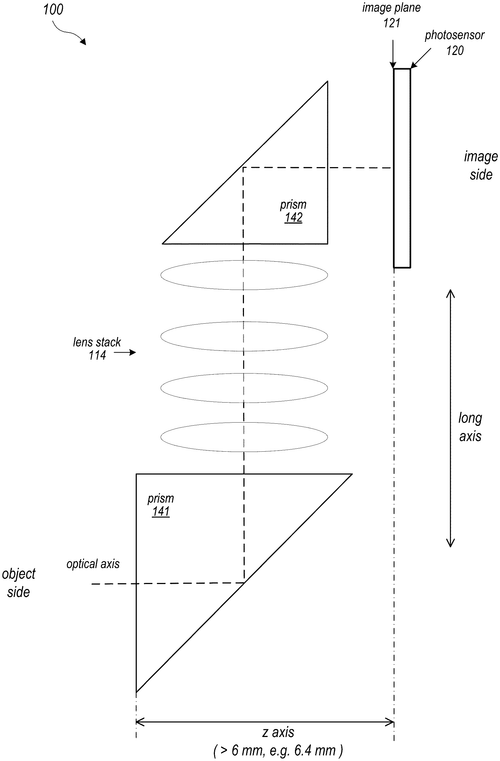
Apple Inc. recently filed a patent for a folded optical system that aims to revolutionize the way we capture images on small and mobile devices. This system, which includes two prisms with refractive power, is designed to provide high-resolution images with a wide field of view in a compact package. By selecting specific materials and surfaces for the prisms, Apple hopes to achieve a low F-number, ensuring sharp and clear pictures. While this patent signals Apple's continued commitment to innovation in the camera technology space, it also raises questions about how this technology will be integrated into their existing product lineup. Will we see this folded optical system in the next iPh. one, competing against the top camera systems from other tech giants like Samsung and Google? And what potential uses could this technology have beyond mobile devices? What do you think about Apple's latest optical system patent? How do you see it shaping the future of photography on small devices? Share your thoughts in the comments below.
Abstract
A folded optical system that comprises two prisms with refractive power and in which at least one surface of at least one of the prisms is not rotationally symmetric. The materials and surfaces of the prisms in the folded optical system may be selected to provide a low F-number (e.g., <=2.4), full field of view (FOV) of 30 degrees or less. The folded optical system may be implemented in a small package size while still capturing sharp, high-resolution images, making embodiments of a camera including the folded optical system suitable for use in small and/or mobile multipurpose devices. A folded optical system that comprises two prisms with refractive power and in which at least one surface of at least one of the prisms is not rotationally symmetric. The materials and surfaces of the prisms in the folded optical system may be selected to provide a low F-number (e.g., <=2.4), full field of view (FOV) of 30 degrees or less. The folded optical system may be implemented in a small package size while still capturing sharp, high-resolution images, making embodiments of a camera including the folded optical system suitable for use in small and/or mobile multipurpose devices.
US Patent 12032146
Apple Inc.
"Apple Patents Innovation in Automation Control for Mobile Machines"
What is this invention?
Automation control using stop trajectories
In an embodiment, automation's sleek,
Controls actuators with technique,
Stop trajectories form,
To avoid any harm,
Bringing mobile machine to a chic peak.

Apple Inc. is aiming to revolutionize automation with a patent that describes a system where an automation controller regularly creates stop paths for a mobile machine. This controller can then guide the machine along these paths. Even if new stop paths are not being generated for some reason, the system can still utilize the latest created stop path to ensure a safe stop for the machine. This innovative technology could potentially streamline the automation process and enhance safety measures in various industries. Competitors in the automation sector, such as Google and Tesla, have also been making strides in similar autonomous technologies. However, Apple's patent introduces a unique approach by focusing specifically on the generation and utilization of stop paths. Imagine the possible applications of this technology in factories, warehouses, or even transportation systems. The thought of machines autonomously following precise stop paths opens up a world of possibilities for increased efficiency and reduced human error. Will Apple be able to translate this patent into a practical product that will significantly impact the automation industry? Share your thoughts on the potential of this technology in the comments below.
Abstract
In an embodiment, an automation controller periodically generates stop trajectories and controls actuators to follow the stop trajectories. As long as new stop trajectories continue to be generated, the automation controller may follow a destination trajectory that is formed from the first portion of each stop trajectory. If stop trajectories are not generated for a period of time (e.g., due to failure in one or more computers generating the stop trajectories), the automation controller may continue to follow the most recent stop trajectory and bring the mobile machine to a stop. In an embodiment, an automation controller periodically generates stop trajectories and controls actuators to follow the stop trajectories. As long as new stop trajectories continue to be generated, the automation controller may follow a destination trajectory that is formed from the first portion of each stop trajectory. If stop trajectories are not generated for a period of time (e.g., due to failure in one or more computers generating the stop trajectories), the automation controller may continue to follow the most recent stop trajectory and bring the mobile machine to a stop.
US Patent 12032378
QUALCOMM Incorporated
"Revolutionizing Location Accuracy with Qualcomm's Innovative Anomaly Detection Technology"
What is this invention?
Positioning when SPS information is spoofed
In a world of SPS signals quite fraught,
Detecting anomalies, it's sought.
UEs share location quite keenly,
When SPS fails, they work serenely.
Confidence in data, carefully caught.
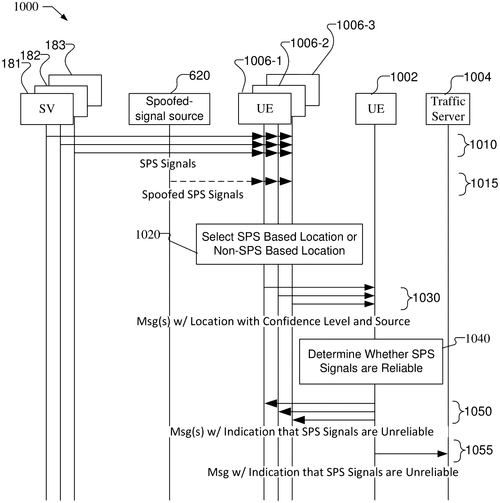
In a world where accurate location information is crucial for a multitude of applications, QUALCOMM Incorporated has developed cutting-edge techniques to enhance location accuracy in the face of unreliable signals. This innovative patent aims to tackle the issue of spoofed satellite positioning system (SPS) signals and improve the transmission of precise location estimates between user equipments (UEs). By determining confidence levels based on various factors such as time, location derived from SPS signals, non-SPS sensor information, and data from other UEs, this technology allows UEs to select the most reliable location estimate to share with others. This method could revolutionize location-based services and applications, ensuring users receive accurate and trustworthy information even in the presence of anomalous signals. Competing products in the market may face a challenge if QUALCOMM's techniques are successfully implemented, as the enhanced reliability and confidence levels offered by this innovation could set a new standard in location accuracy. Imagine the potential applications of this technology in emergency response systems, transportation navigation, and augmented reality experiences. How do you think this advancement could impact the way we interact with location-based services in the future? Share your thoughts in the comments below!
Abstract
Techniques are discussed herein for detecting anomalous signals such as spoofed satellite positioning system (SPS) signals and for the transmission of accurate location estimates between user equipments (UEs) when the SPS signals are not reliable. A UE determines an SPS derived location estimate and determines an associated confidence level. The confidence level is determined based on time or location derived from the SPS signals, e.g., relative to local time or non-SPS information, such as stored previous location estimates, non-SPS sensor information, and location information from other UEs. The UE transmits location information to other UEs that includes a selected location estimate, confidence level, and the source of the location estimate, e.g., where the SPS derived location estimate is selected if the confidence level is high and the non-SPS derived location estimate is selected if the confidence level is low. Techniques are discussed herein for detecting anomalous signals such as spoofed satellite positioning system (SPS) signals and for the transmission of accurate location estimates between user equipments (UEs) when the SPS signals are not reliable. A UE determines an SPS derived location estimate and determines an associated confidence level. The confidence level is determined based on time or location derived from the SPS signals, e.g., relative to local time or non-SPS information, such as stored previous location estimates, non-SPS sensor information, and location information from other UEs. The UE transmits location information to other UEs that includes a selected location estimate, confidence level, and the source of the location estimate, e.g., where the SPS derived location estimate is selected if the confidence level is high and the non-SPS derived location estimate is selected if the confidence level is low.
US Patent 12032072
QUALCOMM Incorporated
"Revolutionizing Wireless Positioning with Reconfigurable Intelligent Surfaces: Qualcomm's Latest Patent"
What is this invention?
Reconfigurable intelligent surface assisted radio frequency fingerprinting for positioning
In the realm of wireless positioning, disclosed,
Techniques with RFFPs proposed,
Network entity's location quest,
Channel info put to the test,
RIS states revealed, accuracy imposed.
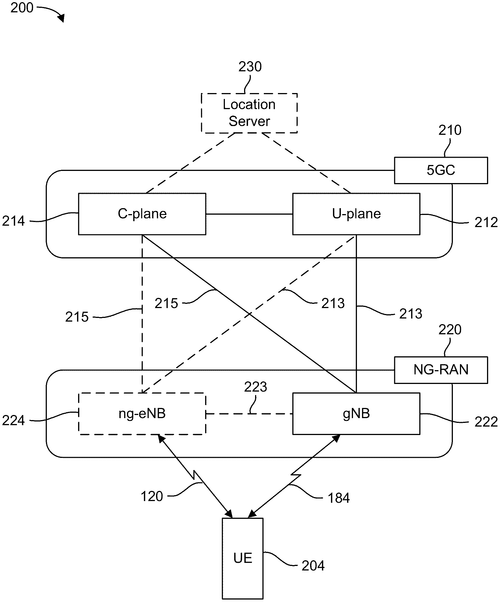
In a recent patent application, QUALCOMM Incorporated has introduced a groundbreaking technology for wireless positioning. This innovation allows a network entity to pinpoint the location of a wireless device within a specific area by analyzing the channel characteristics and utilizing radio frequency fingerprints (RFFPs). What sets this advancement apart is the incorporation of reconfigurable intelligent surfaces (RIS) within the region of interest, which create varying channel conditions that aid in accurate localization. Competitors in the wireless positioning market, such as Google's GPS and Apple's location services, may face tough competition if QUALCOMM's patent becomes a reality. Imagine the potential uses of this technology in improving navigation systems, enhancing augmented reality experiences, and revolutionizing location-based services in smart cities. But the question remains: Will this cutting-edge wireless positioning technique see the light of day in consumer products anytime soon? Share your thoughts on the viability of implementing this invention in the comments below.
Abstract
Disclosed are techniques for wireless positioning. In an aspect, a network entity, such as a location server, may determine information characterizing a channel associated with a wireless device within a region of interest. The network entity may determine a location of the wireless device within the region of interest based on that information and a set of radio frequency fingerprints (RFFPs), where each RFFP identifies a geographic location within a region of interest and a channel condition at that geographic location within the region of interest, and where each geographic location within the region of interest is represented by a set of RFFPs having different channel conditions due to different states of at least one reconfigurable intelligent surface (RIS) within the region of interest. Disclosed are techniques for wireless positioning. In an aspect, a network entity, such as a location server, may determine information characterizing a channel associated with a wireless device within a region of interest. The network entity may determine a location of the wireless device within the region of interest based on that information and a set of radio frequency fingerprints (RFFPs), where each RFFP identifies a geographic location within a region of interest and a channel condition at that geographic location within the region of interest, and where each geographic location within the region of interest is represented by a set of RFFPs having different channel conditions due to different states of at least one reconfigurable intelligent surface (RIS) within the region of interest.
US Patent 12032083
QUALCOMM Incorporated
"QUALCOMM Unveils Groundbreaking Wireless Communication Technology for On-Demand Sidelink Position Estimation"
What is this invention?
Sidelink anchor group for sidelink position estimation
In wireless communication's domain,
Position estimation brings fame.
Sidelink anchors assist with grace,
Using PRS in on-demand pace,
Dynamic tech plays the positioning game.
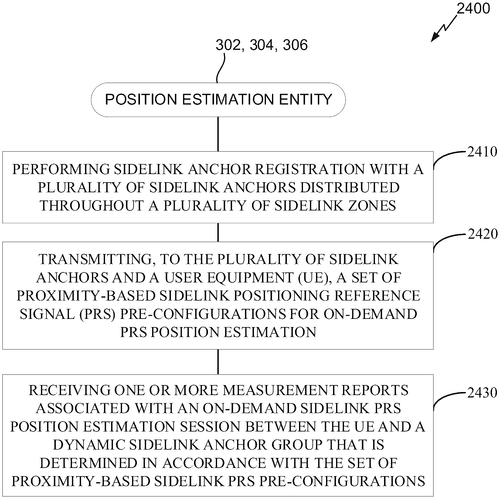
In a recent patent filed by QUALCOMM Incorporated, new techniques for wireless communication have been revealed. This innovation involves a method for assisting devices in determining their position through proximity-based signals. Imagine vehicles communicating with nearby infrastructure to enhance navigation systems or emergency response coordination. Competitors in the field of wireless communication, such as Huawei and Intel, may need to take note of this potential game-changer in location tracking and networking capabilities. The integration of on-demand positioning reference signals could revolutionize how devices interact and share information wirelessly. Could this advancement pave the way for a more connected and efficient world? How do you envision this technology being utilized in your everyday life?
Abstract
Disclosed are techniques for wireless communication. In an aspect, a position estimation entity provides assistance data to sidelink anchors and a UE. The assistance data may include a set of proximity-based sidelink positioning reference signal (PRS) pre-configurations for on-demand PRS position estimation. The target UE transmits a sidelink PRS trigger to trigger an on-demand sidelink PRS position estimation session with a dynamic sidelink anchor group, the sidelink PRS trigger configured to indicate a sidelink zone associated with the UE and a proximity requirement for participation in the on-demand sidelink PRS position estimation. At least one sidelink anchor determines that the proximity requirement to the sidelink zone is satisfied, selects a proximity-based sidelink PRS pre-configuration based on a dynamic proximity to the sidelink zone, and performs a sidelink PRS exchange with the UE. Disclosed are techniques for wireless communication. In an aspect, a position estimation entity provides assistance data to sidelink anchors and a UE. The assistance data may include a set of proximity-based sidelink positioning reference signal (PRS) pre-configurations for on-demand PRS position estimation. The target UE transmits a sidelink PRS trigger to trigger an on-demand sidelink PRS position estimation session with a dynamic sidelink anchor group, the sidelink PRS trigger configured to indicate a sidelink zone associated with the UE and a proximity requirement for participation in the on-demand sidelink PRS position estimation. At least one sidelink anchor determines that the proximity requirement to the sidelink zone is satisfied, selects a proximity-based sidelink PRS pre-configuration based on a dynamic proximity to the sidelink zone, and performs a sidelink PRS exchange with the UE.
US Patent 12032085
QUALCOMM Incorporated
"Qualcomm's Smart Resource Allocation Patented for Optimal Power and Performance in Portable Computing Devices"
What is this invention?
Smart resource allocation framework for dynamic allocation of system resources in personal computing devices (PCDs) that employ wireless modems
In PCDs, a smart system reigns,
Resource allocation with brains,
Preventing power's fall,
And user discomfort stall,
In Mod. Pow.-Perf. mode it maintains.

In the competitive world of portable computing devices, QUALCOMM Incorporated has filed a patent for a smart resource allocation framework (SRAF) that aims to prevent power and performance degradation while keeping the device's temperature in check. This innovative system is triggered during phone calls and dynamically allocates system resources to maintain optimal power and performance levels. With competitors constantly striving to improve battery life and prevent overheating issues in their devices, QUALCOMM's patent introduces a promising solution that could enhance user experiences. Imagine a smartphone that never slows down or overheats, providing seamless performance even during resource-intensive tasks. But the question remains: Will this cutting-edge technology be implemented in future portable computing devices, or will it remain just a patent on paper? Share your thoughts on the feasibility and potential impact of QUALCOMM's invention in the comments below.
Abstract
Systems, methods and computer-readable mediums may be used in portable computing devices (PCDs) for dynamically allocating system resources in a way that prevents or lessens degradation of power and performance KPIs while also avoiding temperature increases in the PCD that can create unpleasant user experiences. A smart resource allocation framework (SRAF) is triggered when a call is received or placed. Once triggered, the SRAF framework monitors a preselected set of state conditions to determine whether or not to place the wireless modem in a modem power-performance (Mod. Pow.-Perf) mode. If it determines that modem is to be placed in the Mod. Pow.-Perf. mode, a Mod. Pow.-Perf. process is performed dynamically allocates system resources and preferably also triggers a thermal framework that performs power reduction in one or more non-modem processing cores. Systems, methods and computer-readable mediums may be used in portable computing devices (PCDs) for dynamically allocating system resources in a way that prevents or lessens degradation of power and performance KPIs while also avoiding temperature increases in the PCD that can create unpleasant user experiences. A smart resource allocation framework (SRAF) is triggered when a call is received or placed. Once triggered, the SRAF framework monitors a preselected set of state conditions to determine whether or not to place the wireless modem in a modem power-performance (Mod. Pow.-Perf) mode. If it determines that modem is to be placed in the Mod. Pow.-Perf. mode, a Mod. Pow.-Perf. process is performed dynamically allocates system resources and preferably also triggers a thermal framework that performs power reduction in one or more non-modem processing cores.
US Patent 12032426
QUALCOMM Incorporated
"Revolutionizing Device Security: Qualcomm's Patent for Advanced Touchscreen Fingerprint Authentication"
What is this invention?
Apparatus and method for device security
In tech's realm of device security,
Fingerprints hold the key majestically,
First image for authentication clear,
Second's difference brings the answer near,
A touch on the touchscreen sets the boundary free.

In a bid to revolutionize device security, QUALCOMM Incorporated has patented an innovative apparatus and method that could potentially change the game. The technology involves acquiring a fingerprint image on a touchscreen, conducting an authentication process based on the initial fingerprint image, then capturing a second fingerprint image to determine any differences between the two. If the disparity surpasses a specific threshold, a secondary authentication process is initiated. This cutting-edge approach could potentially outshine current fingerprint recognition systems found in competitor products, offering an added layer of security and accuracy in device authentication. Imagine a future where your smartphone not only unlocks with just a touch of your finger but also enhances security through dual fingerprint verification. Will this patented technology from QUALCOMM Incorporated mark a new era in device security, or will it remain confined to the realms of intellectual property? How do you envision the integration of such advanced security measures into everyday devices? Share your thoughts in the comments below.
Abstract
An apparatus and method for device security, wherein a fingerprint image is acquired on a touchscreen, and an authentication process is performed based on the first fingerprint image. Thereafter, a second fingerprint image is acquired and a difference between a characteristic of the first and second fingerprint images is determined, and based upon whether this difference is greater than a threshold, a second authentication process is performed. An apparatus and method for device security, wherein a fingerprint image is acquired on a touchscreen, and an authentication process is performed based on the first fingerprint image. Thereafter, a second fingerprint image is acquired and a difference between a characteristic of the first and second fingerprint images is determined, and based upon whether this difference is greater than a threshold, a second authentication process is performed.
US Patent 12032667
HUAWEI TECHNOLOGIES CO., LTD.
Innovative BERT Method Enhances Bit Error Rate Testing for Huawei Processing Units
What is this invention?
System and method for receiver equalization and stressed eye testing methodology for DDR5 memory controller
There once was a method so neat
For testing the bit error rate fleet
With a BERT in the mix
Transmit signals that fix
And calculate errors complete.
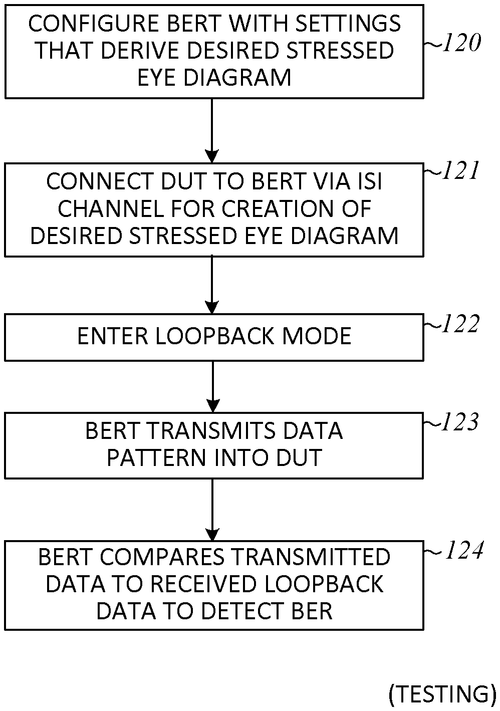
Huawei Technologies Co., Ltd. has recently filed a patent for a method that could revolutionize the way processing units are tested for bit error rates. This new method involves utilizing a bit error rate tester (BERT) to transmit signal pairs to a receiver of the processing unit, ensuring that the jitter levels are within a specified threshold. By tuning the signal pair and obtaining stressed eye measurements, the system can accurately calculate the bit error rate. Competitors in the market, such as Cisco and Intel, currently offer similar testing methods, but Huawei's method appears to offer more precise measurements and compliance with industry standards. Potential uses for this technology could be in the manufacturing process of computer processors, networking equipment, and telecommunications devices to ensure high performance and reliability. Will this innovative method from Huawei become the new industry standard for bit error rate testing in processing units? How might this advancement impact the development of future technologies? Share your thoughts in the comments below.
Abstract
A method for bit error rate testing a processing unit using a bit error rate tester (BERT) includes transmitting a signal pair to a receiver of the processing unit, the signal pair having jitter levels complying with a jitter threshold, tuning the signal pair to obtain a first stressed eye measurement for the receiver, wherein the first stressed eye measurement complies with a stressed eye mask, placing the processing unit into a loop-back mode, wherein data transmitted to the processing unit by the BERT is transmitted back to the BERT, transmitting a data pattern to the processing unit, receiving a looped back version of the data pattern from the processing unit, and calculating a bit error rate in accordance with the data pattern and the looped back version of the data pattern. A method for bit error rate testing a processing unit using a bit error rate tester (BERT) includes transmitting a signal pair to a receiver of the processing unit, the signal pair having jitter levels complying with a jitter threshold, tuning the signal pair to obtain a first stressed eye measurement for the receiver, wherein the first stressed eye measurement complies with a stressed eye mask, placing the processing unit into a loop-back mode, wherein data transmitted to the processing unit by the BERT is transmitted back to the BERT, transmitting a data pattern to the processing unit, receiving a looped back version of the data pattern from the processing unit, and calculating a bit error rate in accordance with the data pattern and the looped back version of the data pattern.
US Patent 12032018
HUAWEI TECHNOLOGIES CO., LTD.
"Revolutionary Flexible Display Method by Huawei Technologies Adapts to User's Needs Instantly"
What is this invention?
Display method for flexible display, and terminal
There's a method to make a display flexible,
Allowing users to be quite versatile,
Switching from one state to the next,
Keeping your apps truly complex,
A tech marvel, truly incredible.

In a recent patent filed by HUAWEI TECHNOLOGIES CO., LTD., a display method for a flexible display has been described. This innovative technology allows a terminal to receive user input to enable an application on a flexible display. The display then adjusts and shifts the application window based on the physical state of the flexible display. This technology could potentially revolutionize the way we interact with flexible displays, allowing for seamless transitions and optimized display areas based on the user's needs. With competitors such as Samsung and LG also exploring flexible display technology, this patent from HUAWEI showcases their commitment to pushing the boundaries of display innovation. Imagine the possibilities of a smartphone that adapts its display layout based on how you hold it or a tablet that optimizes screen real estate depending on its curvature. The potential applications for this technology are vast and could lead to a more intuitive and user-friendly experience. As we look towards the future of flexible displays, the question remains: How will this technology shape the way we use and interact with our devices on a daily basis? Let us know your thoughts in the comments below.
Abstract
A display method for a flexible display includes receiving, by a terminal from a user, a first operation of enabling a first application on a flexible display, where the flexible display is in a first physical state, displaying, by the terminal, an application window of the first application in a first effective display area on the flexible display, detecting, by the terminal, that the flexible display is switched from the first physical state to a second physical state, and displaying, by the terminal, the application window of the first application in a second effective display area on the flexible display, where the second effective display area is different from the first effective display area. A display method for a flexible display includes receiving, by a terminal from a user, a first operation of enabling a first application on a flexible display, where the flexible display is in a first physical state, displaying, by the terminal, an application window of the first application in a first effective display area on the flexible display, detecting, by the terminal, that the flexible display is switched from the first physical state to a second physical state, and displaying, by the terminal, the application window of the first application in a second effective display area on the flexible display, where the second effective display area is different from the first effective display area.
US Patent 12032410
HUAWEI TECHNOLOGIES CO., LTD.
"Huawei Introduces Groundbreaking Speech Wakeup Technology for Electronic Devices"
What is this invention?
Voice wakeup method and device
In a world of tech-savvy glee,
Voice wakeup is the key you see,
Two mics detecting sounds in flight,
To wake your device in the night,
No keyword needed, just speak free!
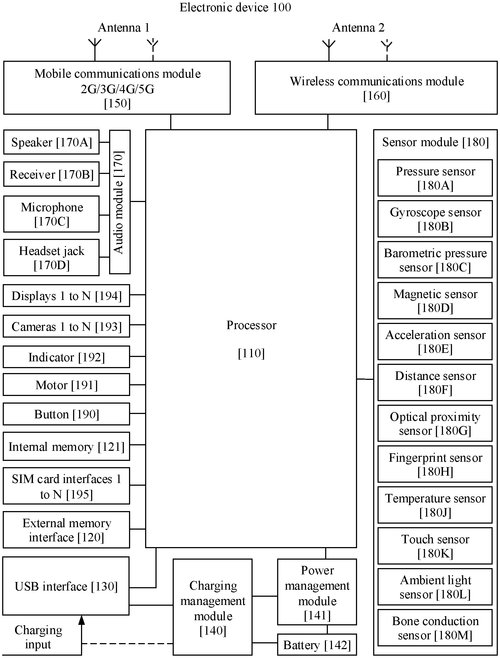
In a recent patent application, HUAWEI TECHNOLOGIES CO., LTD. has introduced a speech wakeup method and device that could revolutionize how we interact with electronic devices. By detecting voice signals through multiple microphones and analyzing the voice energy, this technology could potentially eliminate the need for a specific wakeup keyword, making the process more seamless and intuitive. Competitors in the market, such as Apple's Siri and Amazon's Alexa, currently rely on specific keywords to activate voice assistant features. Huawei's innovation could offer a more natural and spontaneous interaction with electronic devices. Imagine a world where you could simply speak to your device without needing to remember a specific wake-up phrase. This could streamline tasks and enhance user experience in various settings, from smart homes to busy office environments. Will this patent lead to a tangible product that will revolutionize the way we interact with technology? How would you like to see this technology applied in your daily life? Let us know in the comments below.
Abstract
A speech wakeup method and device, and a readable storage medium are provided. The voice wakeup method includes: detecting voice signals that are input into at least two microphones and that meet a first condition; and determining, based on whether voice energy of the voice signals input into the at least two microphones meets a second condition, whether to wake up the electronic device; and if the second condition is met, waking up the electronic device; or if the second condition is not met, continuing to detect a voice signal input into the microphone. The electronic device can be woken up in a wakeup-keyword-free manner. A speech wakeup method and device, and a readable storage medium are provided. The voice wakeup method includes: detecting voice signals that are input into at least two microphones and that meet a first condition; and determining, based on whether voice energy of the voice signals input into the at least two microphones meets a second condition, whether to wake up the electronic device; and if the second condition is met, waking up the electronic device; or if the second condition is not met, continuing to detect a voice signal input into the microphone. The electronic device can be woken up in a wakeup-keyword-free manner.
US Patent 12032421
HUAWEI TECHNOLOGIES CO., LTD.
"Huawei Introduces Innovative Filtering-Based Power Supply Apparatus for Enhanced PSE Efficiency"
What is this invention?
Filtering-based power supply apparatus, power sourcing equipment, and power supply system
In a PSE, a filtering design
Controls power with circuits so fine
Detection's the game
To find out the name
Of devices that properly align
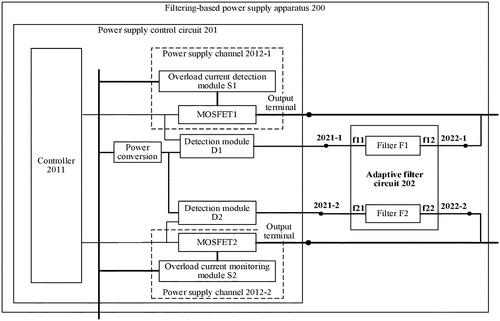
In a recent patent filed by HUAWEI TECHNOLOGIES CO., LTD., a filtering-based power supply apparatus for power sourcing equipment was unveiled. This apparatus boasts a power supply control circuit along with an adaptive filter circuit, designed to enhance the detection process of connected devices. The power supply control circuit features a control switch to manage power supply, paired with a detection module to verify connected devices. The introduction of the adaptive filter circuit aids in eliminating noise during the detection stage, promoting accurate detection of valid powered devices. With competitors in the market offering similar power supply solutions, Huawei's patent hints at a potential advancement in power sourcing equipment technology. Imagine a future where power supply systems can seamlessly and efficiently identify valid powered devices, ensuring optimal performance and safety. As technology continues to evolve, one can't help but wonder: How will advancements in power supply apparatuses shape the landscape of connected devices and smart technologies in the coming years? Share your thoughts in the comments below.
Abstract
A filtering-based power supply apparatus used in a power sourcing equipment (PSE) includes a power supply control circuit and an adaptive filter circuit. The power supply control circuit includes a power supply channel and a detection module. The power supply channel includes a control switch configured to control on and off of the power supply channel. The detection module is configured to send a detection signal to the power supply channel to detect whether a peer device connected to the power supply channel is a valid powered device. The control switch is turned off in a detection process of the power supply channel. The adaptive filter circuit is configured to filter noise in the detection signal in the detection process of the power supply channel. A filtering-based power supply apparatus used in a power sourcing equipment (PSE) includes a power supply control circuit and an adaptive filter circuit. The power supply control circuit includes a power supply channel and a detection module. The power supply channel includes a control switch configured to control on and off of the power supply channel. The detection module is configured to send a detection signal to the power supply channel to detect whether a peer device connected to the power supply channel is a valid powered device. The control switch is turned off in a detection process of the power supply channel. The adaptive filter circuit is configured to filter noise in the detection signal in the detection process of the power supply channel.
US Patent 12032424
****
"Revolutionary Mulching Lawn Mower Blade Patent Unveiled"
What is this invention?
Mulching lawn mower blade
Inventors strive to perfect lawn care,
With mulching blades that cut with great flair,
Base blade, mulching blade pair,
Innovative design, beyond compare,
Mowers now mulch with expert care.

A new patent has been filed for a mulching lawn mower blade that boasts both a base cutting blade and at least one mulching cutting blade. This design allows for more efficient grass cutting and mulching in one go. While similar products from competitors offer either a base cutting blade or a mulching cutting blade, this patent combines both functionalities into one innovative design. The potential uses for this invention could revolutionize lawn care, making it easier and more eco-friendly for homeowners. Imagine the time saved by not having to switch between different blades for cutting and mulching. This could be a game-changer for garden enthusiasts looking to maintain their lawns with minimal effort. However, the question remains: Will this patent be developed into a commercially available product for consumers to purchase? It will be interesting to see if this innovation makes its way into the hands of everyday users or remains merely a concept on paper. What do you think? Would you invest in a lawn mower with this advanced blade design? Share your thoughts in the comments below.
Abstract
A mulching lawn mower blade preferably includes a base cutting blade and at least one mulching cutting blade. The base cutting blade includes a first cutting edge formed on one edge, extending inward from a first end thereof and a second cutting edge formed on an opposing edge, extending inward from a second end thereof. A middle section of the base cutting blade may have any suitable hole (s) or opening pattern (s) to accommodate attachment to a drive shaft of a lawn mower. The at least one mulching cutting blade may be a single mulching cutting blade, which is bolted to the drive shaft, or two separate mulching cutting blades, which are attached to the base cutting blade with any suitable method, such as welding. A first mulching cutting blade includes a first mulching cutting edge and a second mulching cutting blade includes a second mulching cutting edge. A mulching lawn mower blade preferably includes a base cutting blade and at least one mulching cutting blade. The base cutting blade includes a first cutting edge formed on one edge, extending inward from a first end thereof and a second cutting edge formed on an opposing edge, extending inward from a second end thereof. A middle section of the base cutting blade may have any suitable hole (s) or opening pattern (s) to accommodate attachment to a drive shaft of a lawn mower. The at least one mulching cutting blade may be a single mulching cutting blade, which is bolted to the drive shaft, or two separate mulching cutting blades, which are attached to the base cutting blade with any suitable method, such as welding. A first mulching cutting blade includes a first mulching cutting edge and a second mulching cutting blade includes a second mulching cutting edge.
US Patent 12029158
****
"Revolutionizing Tree Limb Management: Innovative Connector for Ornamental Perfection"
What is this invention?
Tree limb hook connector and method of use
There once was a connector so fine
For tree limbs, a creative design
First and second member secure,
Hook and threading, ornaments pure
Bringing plant limbs closer in line.
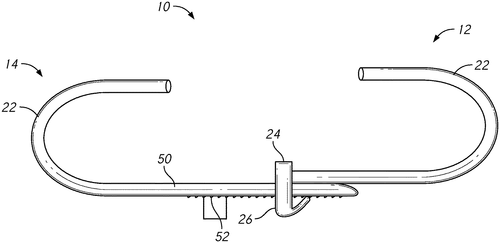
A newly patented tree limb connector and method of use aims to securely hold two limbs of a tree in place, potentially revolutionizing the way we decorate and support our plant life. This innovative device features two members with hooks and threading that connect to tree limbs, providing stability and flexibility in positioning. While there are currently some tree limb connectors on the market, this new invention stands out with its unique design and secure locking mechanism. Imagine being able to bring two plant limbs closer together to reduce bare spots on your Christmas tree or provide additional support for fragile branches. But the question remains: Will this tree limb connector make its way from concept to consumer product? How will it fare against competitors in the market? Share your thoughts on the potential uses and practicality of this invention in the comments below.
Abstract
A tree limb connector and method of use has a first member and second member that, when connected, securely hold two limbs of a tree in place. The device has a first member with a hook at a first end and a hollow receptacle at a second end. A second member has a hook at a first end and a threading on a second end with a length and teeth. Each hook attaches onto one limb of a tree. The threading is pulled into a first end of receptable and out of a second end of the receptacle, held securely in place via a tongue at the second end of the receptacle that catches a rib at a desired length. The present invention and methods may be used to bring two plant limbs closer together to reduce bare spots for ornamental reasons, such as on a Christmas tree, or provide added support. A tree limb connector and method of use has a first member and second member that, when connected, securely hold two limbs of a tree in place. The device has a first member with a hook at a first end and a hollow receptacle at a second end. A second member has a hook at a first end and a threading on a second end with a length and teeth. Each hook attaches onto one limb of a tree. The threading is pulled into a first end of receptable and out of a second end of the receptacle, held securely in place via a tongue at the second end of the receptacle that catches a rib at a desired length. The present invention and methods may be used to bring two plant limbs closer together to reduce bare spots for ornamental reasons, such as on a Christmas tree, or provide added support.
US Patent 12029171
****
"Revolutionizing Pet Bathing: Introducing the Innovative Folding Pet Bathtub"
What is this invention?
Folding pet bathtub
Innovative folding pet bathtub design,
With foldable support, oh so fine,
Linkage components and lock,
For easy use around the clock,
A tech marvel for your canine.

A new patent has been revealed for a folding pet bathtub, perfect for pet owners looking to streamline their grooming routine. The design features a foldable support frame with a flexible bathtub attached, making it easy to set up and put away as needed. The inclusion of a locking device ensures stability during use, while also allowing for compact storage when not in use. Competitors in the pet grooming market may have to step up their game with this innovative invention on the horizon. Imagine the convenience of being able to bathe your furry friend with ease, and then simply fold up the bathtub to save space in your home. But will this folding pet bathtub actually make it to market? While the concept is promising, practical considerations like cost and consumer demand will play a significant role in its success. Would you invest in a folding pet bathtub for your furry companion? Share your thoughts in the comments below.
Abstract
A folding pet bathtub is disclosed, including a foldable support frame and a flexible bathtub provided on the foldable support frame. The foldable support frame includes a support component, a first bracket component and a second bracket component that are foldable and disposed sequentially from top to bottom on an inside of the support component, two sets of linkage components for connecting the first bracket component and the second bracket component, and a locking device disposed on the linkage components for preventing the first bracket component and the second bracket component to be folded. By setting linkage components to drive the first bracket component and the second bracket component to unfold or fold, the folding pet bathtub is not only convenient for daily unfolding use, but also is folded when not in use, which can reduce volume of the bathtub, the structure is simple and convenient to use. A folding pet bathtub is disclosed, including a foldable support frame and a flexible bathtub provided on the foldable support frame. The foldable support frame includes a support component, a first bracket component and a second bracket component that are foldable and disposed sequentially from top to bottom on an inside of the support component, two sets of linkage components for connecting the first bracket component and the second bracket component, and a locking device disposed on the linkage components for preventing the first bracket component and the second bracket component to be folded. By setting linkage components to drive the first bracket component and the second bracket component to unfold or fold, the folding pet bathtub is not only convenient for daily unfolding use, but also is folded when not in use, which can reduce volume of the bathtub, the structure is simple and convenient to use.
US Patent 12029198
****
"New Patent Revolutionizes Pet Furniture Assembly with Fast Disassembly and Assembly"
What is this invention?
Assembled pet rack having fast disassembly and assembly
In a pet rack of latest tech fashion,
Quick assembly is its main passion.
Drawstring members in line,
Make setup a design dine,
Fast disassembly, a poetic reaction!
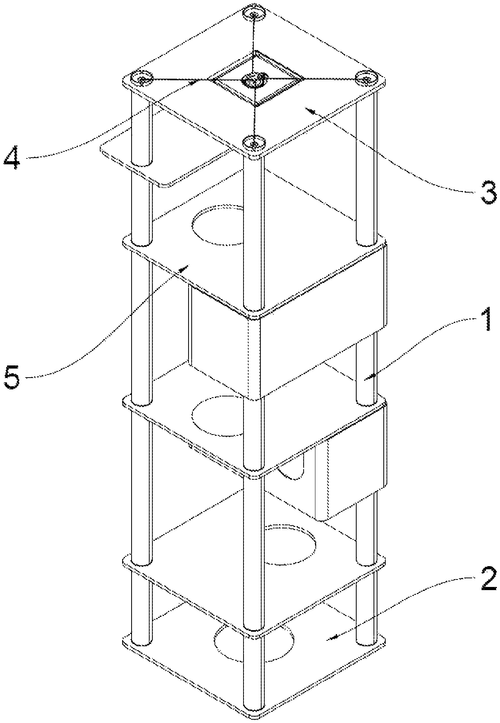
A new patent has been unveiled for an assembled pet rack that boasts fast disassembly and assembly. This innovative design includes a bottom member, a top member, a supporting member, a separating member to allow for multiple resting spaces for pets, and a set of drawstring members that link all the components together seamlessly. By using the drawstring members to connect the pieces in the correct order, assembly is made quicker and simpler, making it easy to take apart and put together. In a market where pet furniture is becoming increasingly popular, with competitors offering various options for pet owners, this new patent presents a unique solution for pet owners looking for convenience and versatility. Imagine being able to quickly set up a comfortable resting space for your furry friends and easily pack it away when not in use. Could this innovative assembled pet rack with fast disassembly and assembly revolutionize the way we provide comfort for our pets at home? Share your thoughts in the comments below.
Abstract
The present disclosure relates to an assembled pet rack having fast disassembly and assembly, comprising: a bottom member; a top member; a supporting member; a separating member arranged on the supporting member for forming multiple spaces for pets to rest; and a plurality of drawstring members, whose one end is fixedly connected with the bottom member, and the other end penetrates the support member and the separating member and then is fixedly connected with the top member for integrally connecting all the above members. In the present disclosure, the drawstring members connect in series the components of the pet rack according to the correct design, thus to complete the correct assembly more quickly and simply, thereby achieving fast disassembly and assembly. Besides, the drawstring members can be staggered on the same plane without disconnecting the drawstring member separately, so the assembled method is fast and diverse, which improves the practicability. The present disclosure relates to an assembled pet rack having fast disassembly and assembly, comprising: a bottom member; a top member; a supporting member; a separating member arranged on the supporting member for forming multiple spaces for pets to rest; and a plurality of drawstring members, whose one end is fixedly connected with the bottom member, and the other end penetrates the support member and the separating member and then is fixedly connected with the top member for integrally connecting all the above members. In the present disclosure, the drawstring members connect in series the components of the pet rack according to the correct design, thus to complete the correct assembly more quickly and simply, thereby achieving fast disassembly and assembly. Besides, the drawstring members can be staggered on the same plane without disconnecting the drawstring member separately, so the assembled method is fast and diverse, which improves the practicability.
US Patent 12029199
****
"Revolutionizing Egg Incubation with Innovative Water Supply Assembly"
What is this invention?
Egg incubator
In the egg incubator so grand,
Technology at work, oh so grand.
Water tanks and mesh,
Innovative tech enmesh,
Hatching life, a genius plan.
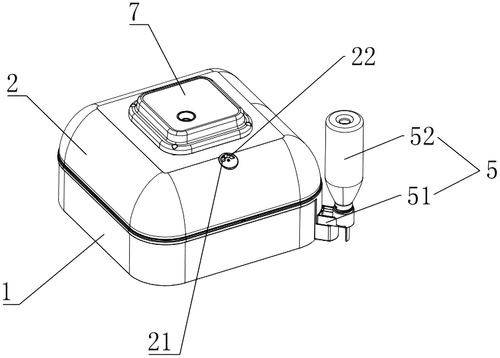
A new patent filed for an innovative egg incubator has caught the attention of tech enthusiasts and poultry farmers alike. This egg incubator boasts features such as multiple water tanks, a mesh plate, and a water supply assembly aimed at creating the optimal environment for hatching eggs. Competitors in the market, such as traditional egg incubators and high-tech smart egg hatchers, may face some stiff competition if this new invention comes to fruition. The incorporation of a heating assembly, egg turning assembly, and efficient water supply system sets this patent apart from the rest. Imagine the potential uses of such a device - from small-scale backyard chicken owners looking to hatch their own eggs, to larger commercial farms streamlining their incubation process. The possibilities seem endless for this new technology. As we await further developments on this patent, one can't help but wonder - will this egg incubator revolutionize the way we hatch eggs in the future? Share your thoughts in the comments below.
Abstract
An egg incubator includes an incubator base, an incubator upper cover, a heating assembly, an egg turning assembly, and a water supply assembly. A first water tank and a second water tank are disposed inside the incubator base. The first water tank and the second water tank are communicated with each other. A third water tank communicated with the second water tank is disposed on one side of the incubator base. A mesh plate is lapped inside the incubator base. An inner wall bottom of the first water tank is higher than an inner wall bottom of the second water tank. A water supply assembly is mounted on the third water tank and the water supply assembly (5) is configured to supply water to the first water tank, the second water tank, and the third water tank. An egg incubator includes an incubator base, an incubator upper cover, a heating assembly, an egg turning assembly, and a water supply assembly. A first water tank and a second water tank are disposed inside the incubator base. The first water tank and the second water tank are communicated with each other. A third water tank communicated with the second water tank is disposed on one side of the incubator base. A mesh plate is lapped inside the incubator base. An inner wall bottom of the first water tank is higher than an inner wall bottom of the second water tank. A water supply assembly is mounted on the third water tank and the water supply assembly (5) is configured to supply water to the first water tank, the second water tank, and the third water tank.
US Patent 12029202